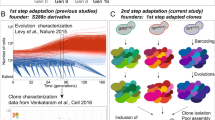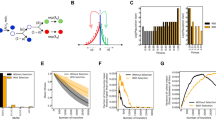Abstract
Because most newly arising mutations are neutral or deleterious, it has been argued1,2,3 that the mutation rate has evolved to be as low as possible, limited only by the cost of error-avoidance and error-correction mechanisms. But up to one per cent of natural bacterial isolates are ‘mutator’ clones that have high mutation rates4,5,6. We consider here whether high mutation rates might playan important role in adaptive evolution. Models of large, asexual, clonal populations adapting to a new environment show that strong mutator genes (such as those that increase mutation rates by 1,000-fold) can accelerate adaptation, even if the mutator gene remains at a very low frequency (for example, 10−5). Less potent mutators (10 to 100-fold increase) can become fixed in a fraction of finite populations. The parameters of the model have been set to values typical for Escherichia coli cultures, which behave in a manner similar to the model in long-term adaptation experiments7.
This is a preview of subscription content, access via your institution
Access options
Subscribe to this journal
Receive 51 print issues and online access
$199.00 per year
only $3.90 per issue
Buy this article
- Purchase on Springer Link
- Instant access to full article PDF
Prices may be subject to local taxes which are calculated during checkout



Similar content being viewed by others
References
Drake, J. W. Aconstant rate of spontaneous mutation in DNA-based microbes. Proc. Natl Acad. Sci. USA 88, 7160–7164 (1991).
Kimura, M. On the evolutionary adjustment of spontaneous mutation rates. Genet. Res. 9, 23–34 (1967).
Leigh, E. G. The evolution of mutation rates. Genetics 73, 1–18 (1973).
Jyssum, K. Observation of two types of genetic instability in Escherichia coli. Acta Pathol. Microbiol. Immunol. Scand. 48, 113–120 (1960).
Gross, M. D. & Siegel, E. C. Incidence of mutator strains in Escherichia coli and coliforms in nature. Mutat. Res. 91, 107–110 (1981).
LeClerc, J. E., Li, B., Payne, W. L. & Cebula, T. A. High mutation frequencies among Escherichia coli and Salmonella pathogens. Science 274, 1208–1211 (1996).
Sniegowski, P. D., Gerrish, P. J. & Lenski, R. E. Evolution of high mutation rates in experimental populations of E. coli. Nature 387, 703–705 (1997).
Liberman, U. & Feldman, M. W. Modifiers of mutation rate: a general reduction principle. Theor. Pop. Biol. 30, 125–142 (1986).
Leigh, E. G. Natural selection and mutability. Am. Nat. 104, 301–305 (1970).
Ishii, K., Matsuda, H., Iwasa, Y. & Sasaki, A. Evolutionary stable mutation rate in a periodically changing environment. Genetics 121, 163–174 (1989).
Van Valen, L. Anew evolutionary law. Evol. Theory 1, 1–30 (1973).
Moxon, E. R., Rainey, P. B., Nowak, M. A. & Lenski, R. E. Adaptive evolution of highly mutable loci in pathogenic bacteria. Curr. Biol. 4, 24–33 (1994).
Haraguchi, Y. & Sasaki, A. Host-parasite arms race in mutation modifications: indefinite escalation despite a heavy load. J. Theor. Biol. 183, 121–137 (1996).
Mao, E. F., Lane, L., Lee, J. & Miller, J. H. Proliferation of mutators in a cell population. J. Bacteriol. 179, 417–422 (1997).
Chao, L. & Cox, E. C. Competition between high and low mutating strains of Escherichia coli. Evolution 37, 125–134 (1983).
Tröbner, W. & Piechocki, R. Competition growth between Escherichia coli mutL and mut+ in continuously growing cultures. Z. Allg. Mikrobiol. 21, 347–349 (1981).
Tröbner, W. & Piechocki, R. Competition between isogenic mutS and mut+populations of Escherichia coli K12 in continuously growing cultures. Mol. Gen. Genet. 198, 175–176 (1984).
Tröbner, W. & Piechocki, R. Selective advantage of polA1 mutator over polA+strains of Escherichia coli in a chemostat. Naturwissenschaften 72, 377–378 (1985).
Chao, L., Vargas, C., Spear, B. B. & Cox, E. C. Transposable elements as mutator genes in evolution. Nature 303, 633–635 (1983).
Ninio, J. Transient mutators: a semiquantitative analysis of the influence of translation and transcription errors on mutation rates. Genetics 129, 957–962 (1991).
Lenski, R. E., Rose, M. R., Simpson, S. C. & Tadler, S. C. Long-term experimental evolution in E. coli. I, Adaptation and divergence during 2000 generations. Am. Nat. 138, 1315–1341 (1991).
Lenski, R. E. & Travisano, M. Dynamics of adaptation and diversification: a 10,000-generation experiment with bacterial populations. Proc. Natl Acad. Sci. USA 91, 6808–6814 (1994).
Hartl, D. L. & Dykhuizen, D. E. The population genetics of Escherichia coli. Annu. Rev. Genet. 18, 31–68 (1984).
Maynard-Smith, J., Smith, N. H., O'Rourke, M. & Spratt, B. G. How clonal are bacteria? Proc. Natl Acad. Sci. USA 90, 4384–4388 (1993).
Matic, I., Taddei, F. & Radman, M. Genetic barriers among bacteria. Trends Microbiol. 4, 69–73 (1996).
Peck, J. R. Aruby in the rubbish: beneficial mutations, deleterious mutations and the evolution of sex. Genetics 137, 597–606 (1994).
David, J. L., Savy, Y. & Brabant, P. Outcrossing and selfing evolution in populations under directional selection. Heredity 71, 642–651 (1993).
Tomlinson, I. P. M., Novelli, M. R. & Bodmer, W. F. The mutation rate and cancer. Proc. Natl Acad. Sci. USA 93, 14800–14803 (1996).
Magnasco, M. O. & Thaler, D. S. Changing the pace of evolution. Phys. Lett. A 221, 287–292 (1996).
Taddei, F., Vulic, M., Radman, M. & Matic, I. in Environmental Stress, Adaptation and Evolution (eds Bijlsma, K. & Loeschcke, V.) (Birkhäuser, Basel, in the press).
Acknowledgements
Most of the simulations used the SP2 computer, at the Centre de Ressources Informatiques de l'Université de Paris-Sud (Orsay). We are grateful to M.-P. Donsimoni for providing us with a favourable environment and to J. Shykoff and N. Smith for eliminating deleterious style and generating favourable comments. This work has been funded by ‘Bureau des Ressources Génétiques, Ministère de l'Environnement, Association de la Recherche contre le Cancer, Actions Concertées Coordonnées-Sciences du Vivant du Ministère de l'Enseignement Supérieur et de la Recherche and Groupement de Recherche et d'Etudes sur les Génomes’.
Author information
Authors and Affiliations
Corresponding authors
Rights and permissions
About this article
Cite this article
Taddei, F., Radman, M., Maynard-Smith, J. et al. Role of mutator alleles in adaptive evolution. Nature 387, 700–702 (1997). https://doi.org/10.1038/42696
Received:
Accepted:
Issue Date:
DOI: https://doi.org/10.1038/42696
This article is cited by
-
Identifying Targets of Selection in Laboratory Evolution Experiments
Journal of Molecular Evolution (2023)
-
Targeted Hypermutation as a Survival Strategy: A Theoretical Approach
Acta Biotheoretica (2023)
-
Population genetics of clonally transmissible cancers
Nature Ecology & Evolution (2022)
-
Sexual selection for males with beneficial mutations
Scientific Reports (2022)
-
Unexpectedly high mutation rate of a deep-sea hyperthermophilic anaerobic archaeon
The ISME Journal (2021)
Comments
By submitting a comment you agree to abide by our Terms and Community Guidelines. If you find something abusive or that does not comply with our terms or guidelines please flag it as inappropriate.



